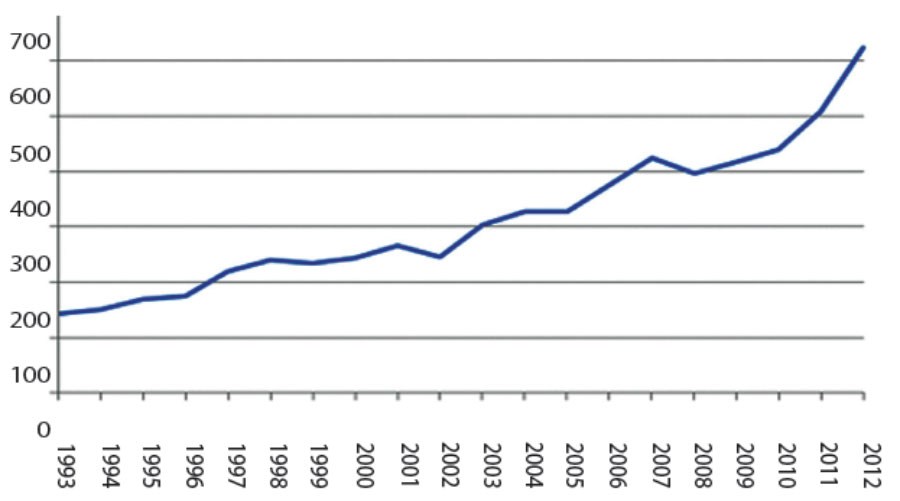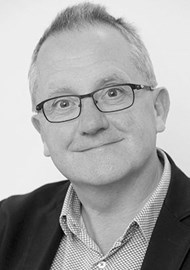One of the aspects of tinnitus that drew me into it becoming a major theme of my clinical and research work was how little work had been done when I began to see patients in the mid 1980s. This struck me as inappropriate given the major impact of tinnitus in the patients that I was seeing, and also as a great opportunity to be involved in increasing understanding and awareness of the condition.
The volume of work on tinnitus published has certainly increased, and Figure 1 illustrates this by demonstrating the number of papers on PubMed published each year in the last 20 years, which has risen from just under three per week in 1993 to 12 per week in 2012/3. Whilst some of this can be attributed to an increase in scientific publication in general, and to developments in otology and audiology specifically, the breadth and depth of the literature being published is heartening, including as it does papers in higher profile, and higher impact factor journals than previously ([1-3] for example).

Figure 1: Tinnitus papers published per year.
In this tinnitus-themed edition of Audiology Matters (see Jan/Feb 2014 edition features) I have requested colleagues to summarise our present situation with tinnitus from a number of different perspectives and I warmly thank them. Prof Jos Eggermont has extensively investigated the neurophysiology of tinnitus, and he considers what animal models have told us about tinnitus and hyperacusis. Writing also from an auditory neuroscience perspective, Prof Deborah Hall reflects upon what functional neuroimaging has revealed about tinnitus. Readers will of course know of the work of Prof Brian Moore, FRS in the hearing aid and psychoacoustics fields – what is less well known is that he has a significant interest in tinnitus, and particularly in how the perceptual characteristics of tinnitus can be measured. I am grateful that Brian has shared his insights with us. Other metrics of tinnitus are of course important, and Kathryn Fackrell and Dr Derek Hoare describe the current status of tinnitus questionnaires, information that will be of use to all who use tinnitus outcome measures, either in clinical or research contexts.
Moving to treatments, Mr Rishi Sharma and Mr Don McFerran, both otolaryngologists, reflect upon clinical research using intra-tympanic drug treatments for tinnitus. From an entirely different perspective, Dr Rosie Kentish describes the use of narrative therapy in her work with tinnitus in childhood, involving drawing pictures and telling stories to enter the world of a child (and their family) with tinnitus. The challenge of optimising hearing benefit for tinnitus is reviewed by Dr Grant Searchfield, with some practical strategies that I am sure will benefit patients in many countries. Writing from their perspective as clinical psychologists, Dr Liz Marks and Dr Laurence McKenna describe the use of mindfulness meditation for individuals with troublesome tinnitus, and the benefits that can derive from encouraging such persons to exist in the present moment. Closing this edition, Prof Berthold Langguth shares exciting news about the instigation of the TINNET pan European tinnitus research network, which aims to address the issues raised by the heterogeneity of tinnitus, and holds great promise.
Whilst some of these authors indicate that progress remains slow, the very substantial work that is now underway and that is planned on tinnitus worldwide is greatly encouraging, and gives cause for hope. The multidisciplinary and international nature of the authorship of this edition is also heartening, and is a practical demonstration of the ways that inter-disciplinary collaboration is being brought to bear on the tinnitus problem worldwide. Considerable work has been done, but there is much more to do, and the TINNET research network is a model of how the tinnitus community can work together with the common goal of improved and novel treatments. I hope that this edition of Audiology Matters serves as an encouragement, an inspiration and perhaps a challenge for us to redouble our efforts.
References
1. Cima RF, Maes IH, Joore MA, et al. Specialised treatment based on cognitive behaviour therapy versus usual care for tinnitus: a randomised controlled trial. Lancet 2012;26;379(9830):1951-9.
2. Langguth B, Kreuzer PM, Kleinjung T, De Ridder D. (2013) Tinnitus: causes and clinical management. Lancet Neurol 2013;12(9):920-30.
3. Baguley D, McFerran D, Hall D. Tinnitus. Lancet 2013;382(9904):1600-7.
Declaration of Competing Interests: I have written extensively about tinnitus, and have served as an expert witness. I have delivered consultancy advice for a variety of pharmaceutical and audiological organisations.




